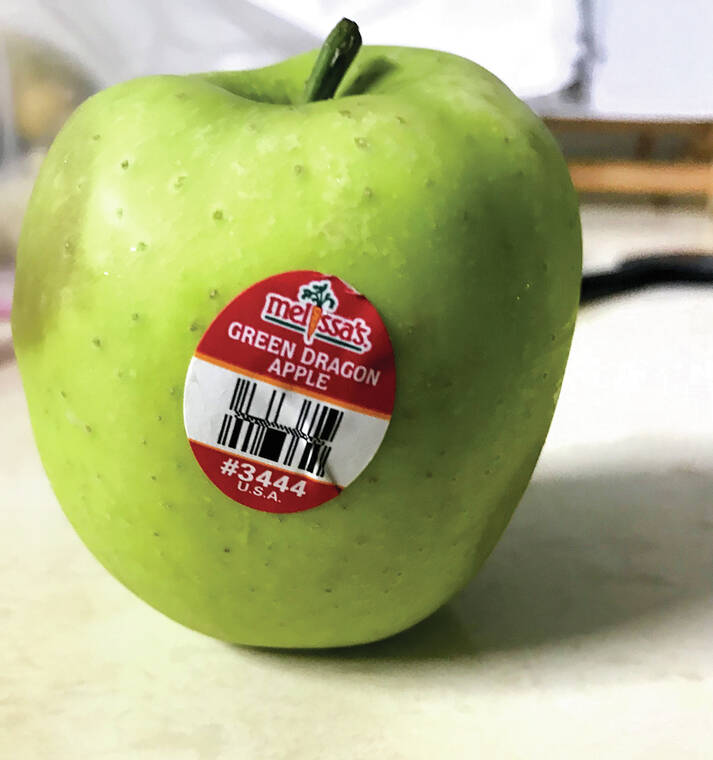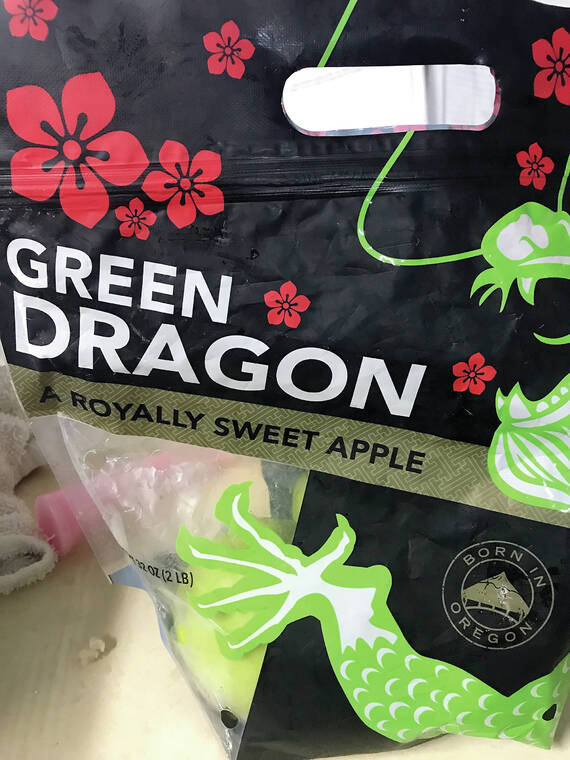The Green Dragon apple has its roots in Japan in the 1920s, with the name of Chinese origin which was the ancient symbol for royalty.
First planted in the Pacific Northwest in 1984, the Green Dragon loves the mild autumn sun of that area and thrived.
They say “Don’t judge a book by its cover,” and this apple, although green, has a complex sweetness and very low acidity. If you close your eyes, you would think you were eating a fragrant Pacific Rose apple. There are hints of pineapple and pear flavors, gives a refreshing twist and is one of the most fragrant apples on the market.
These apples are perfect for pies, muffins, tarts or chopped into fresh salads. Its sweetness pairs well with cranberries, pears, strawberries and cinnamon.
Green dragon apples last in the refrigerator for 2 to 3 weeks.
Interested in trying the Green Dragon apple? They were available in the produce section at KTA Puainako.
• • •
Here’s a recipe for an apple salad with miso dressing:
Lemony Baby Bok Choy, Green Dragon Apple and Miso Salad
Serves 4
Salad
4 heads baby bok choy
1 large Green Dragon apple, skin left on
1 shallot, minced
1 teaspoon fresh Meyer lemon
2-3 tablespoons Sweet Miso Salad
Sweet Miso Dressing
6 tablespoons neutral oil, such as vegetable, canola or grapeseed
4 teaspoons miso paste
1/2 teaspoon sesame oil
2 tablespoons maple syrup, honey or agave
1 teaspoon lower-sodium soy sauce
A few pinches black sesame seeds
Combine all ingredients in a wide-mouth jar, and whirl using an immersion blender. Set aside.
Clean, dry and chop bok choy into small dice, using both the crunchy stalks and the green leaves. Place in a large salad bowl. Core the apple and finely chop it; add to the bowl. Peel and finely mince the shallot; add to the bowl.
Add the lemon juice and stir to combine to prevent the apple from turning color.
Add the sweet miso dressing and toss lightly to coat salad. Place in salad bowl and garnish with a few pinches of black sesame seeds.
Red Delicious apples
Once touted as “the world’s favorite snacking apple,” the Red Delicious of today is mealy and has no taste. Additionally it is covered with wax, which makes it even more unappetizing. It is given to school kids, which is usually thrown out.
The Red Delicious was first called Hawkeye, first found on Jesse Hiatt’s fast in Peru, Iowa around 1870. Being a Quaker, he thought that “because of its persistence, maybe it deserved to live.” The original Red Delicious apple was very delicious but it wasn’t red. It was red and yellow-striped. There was a hint of pineapple or melon flavors, and was fruity and sweet.
C.M. Stark said it was the best apple he had ever eaten and his nursery bought the rights in 1914 and gave it the Red Delicious name. Its “very voluptuous top that elongated into five points on the bottom had great eye appeal.” With promotion and marketing, the Red Delicious captured 90% of the apple crop at that time.
Then the Stark Nursery kept breeding the Red Delicious apples to produce a redder and redder apple but paid no attention to the taste.
“In the 1950s, as Red Delicious was developing, there was a major shift in the way Americans bought food,” says Mike Beck who tends 80 acres at Uncle John’s Cider Mill. People started buying with their eyes and there was no doubt that the Red Delicious is a pretty apple.
“The strive for a better retail presentation led orchardists and nurserymen to try to design and crossbreed that Red Delicious to get that perfect dark red color and those perfect five little bumps on the bottom,” says Paul Vander Heide, owner of Vander Mill Cider. “And in the process, they forgot that things have got to taste good.”
Joe Heron, the founder and former owner of Crispin Cider says, “Our expectation of an apple is now driven by Honey Crisp, which is just sweet enough, just crisp enough.”
If you want a really great Red Delicious apple, it needs to be left on the tree so long that a condition called watercore develops. “What that means is the starches and sugars get converted to sorbitol or unfermentable sugar. They’re very sweet, but they don’t last long.
So if you want a better tasting Red Delicious, you need to go to the orchard and pick them from the tree or buy them from the farmer … or buy instead a Fuji, which is a descendant of the Red Delicious.
So if you have Red Delicious apples in your refrigerator, eat them with cheese or peanut butter.
No wonder the Red Delicious apples have been taken down to plant Cosmic Crisp apples in the Northwest.
Foodie bites
Hawaii Community College’s Culinary Program’s Cafeteria and Da ‘Ohana Corner Cafe is open this week for take-out orders on Tuesday, Wednesday and Thursday. Call The Cafeteria at 808-934-2559 and da ‘Ohana Corner Cafe at 808-934-2591 for orders. Please provide your order, your name, phone number, and pick up time when you place your orders with the students.


